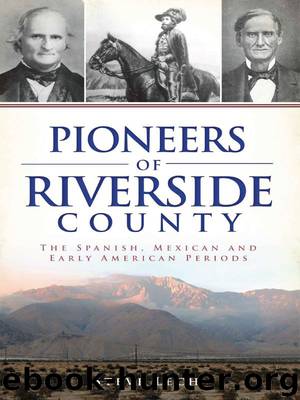Pioneers of Riverside County: The Spanish, Mexican, and Early American Periods by Steve Lech

Author:Steve Lech [Lech, Steve]
Language: eng
Format: epub
Publisher: Arcadia Publishing Inc.
Published: 2012-11-20T00:00:00+00:00
10
THE SONORA ROAD, II
DEVELOPMENTS ALONG THE SONORA ROAD114
Let us now take a look at the physical effects the large burst of population had on the Riverside County portion of the Sonora Road and the settlements that ensued. The last two stops in present-day San Diego County were Warner’s Ranch and then Oak Grove. From Oak Grove, the road entered Riverside County at Aguanga, a name that dated from the Spanish era for the Indian rancheria existing there. The stop for the Butterfield stage, though, was a place known in the earliest days as the “Dutchman’s.” This was a ranch owned by Joseph Gifthaller, described in the 1860 census as a forty-four-year-old farmer from Bavaria.115 Gifthaller’s ranch was approximately 1.75 miles west of the present-day town of Aguanga. Gifthaller’s property would have been merely a changeover stop, wherein fresh horses could be traded for the weary ones.
Approximately four years later, Jacob Bergman, one of the first drivers of the Butterfield stages between Yuma and Los Angeles, decided to settle in this valley and bought the Gifthaller ranch. This stop then became known as Bergman’s, and Bergman ran his ranch and maintained the station. This station lasted for many years and served as the hub for the town of Aguanga, which began to develop in the area around 1870.
The next stop, and the first major stop along the road within Riverside County, was ten miles west at Temecula. In the earliest days, travelers camped along the river in the vicinity of the Indian village that sat on a bluff on the south side of Temecula Creek. For provisions, they probably traded with the local Indians. By the time of the Sonoran migration, Pablo Apis, grantee of the Little Temecula Rancho, had established a home and orchard in the middle of the Pauba Valley. As was the custom at that time, his home became a way station along the route. Here, Apis sold and/or traded goods and materials to travelers if he had any with which to part.
By the mid-1850s, another person had taken over the role of “shopkeeper” at Temecula. This person was John Magee, an American originally from New York. Magee settled in the valley around this time and built a small adobe home and store approximately one hundred to two hundred yards east of the Temecula Indian village. Here, Magee sold provisions to travelers, and a small community of local farmers and colonizers began to form in the area. Magee’s store became the hub of the community of Temecula, sometimes called “Old Temecula” by historians. By the time John Butterfield began delivering mail on a regular basis, Magee played host to Riverside County’s first post office, opened in his store on April 22, 1859.116
Magee continued to run the store and post office sporadically for the next few years. During the 1860s, he was joined in his endeavors by a Frenchman named Louis Wolf, who eventually took over as the main storekeeper and postmaster in Temecula. Although Wolf continually moved between San Diego, Warner’s Ranch and Temecula, by 1868 he had constructed his own store at Temecula.
Download
This site does not store any files on its server. We only index and link to content provided by other sites. Please contact the content providers to delete copyright contents if any and email us, we'll remove relevant links or contents immediately.
Shoot Sexy by Ryan Armbrust(17560)
Portrait Mastery in Black & White: Learn the Signature Style of a Legendary Photographer by Tim Kelly(16873)
Adobe Camera Raw For Digital Photographers Only by Rob Sheppard(16800)
Photographically Speaking: A Deeper Look at Creating Stronger Images (Eva Spring's Library) by David duChemin(16501)
Bombshells: Glamour Girls of a Lifetime by Sullivan Steve(13691)
Art Nude Photography Explained: How to Photograph and Understand Great Art Nude Images by Simon Walden(12854)
Perfect Rhythm by Jae(5076)
Pillow Thoughts by Courtney Peppernell(4020)
The Book of Joy by Dalai Lama(3702)
Good by S. Walden(3353)
The Pixar Touch by David A. Price(3220)
A Dictionary of Sociology by Unknown(2858)
Fantastic Beasts: The Crimes of Grindelwald by J. K. Rowling(2849)
Stacked Decks by The Rotenberg Collection(2691)
Humans of New York by Brandon Stanton(2690)
Read This If You Want to Take Great Photographs by Carroll Henry(2603)
On Photography by Susan Sontag(2489)
Photographic Guide to the Birds of Indonesia by Strange Morten;(2408)
Insomniac City by Bill Hayes(2399)
